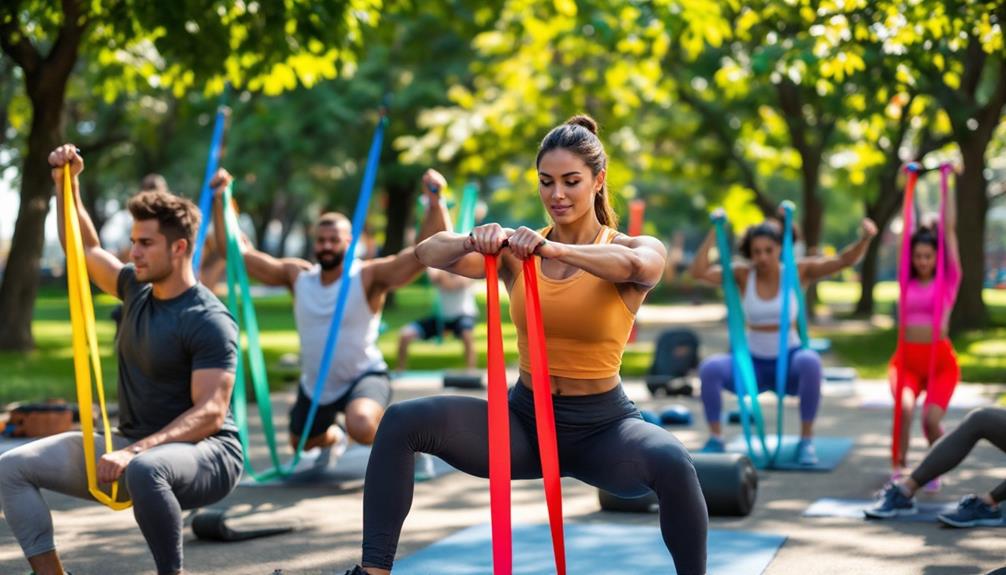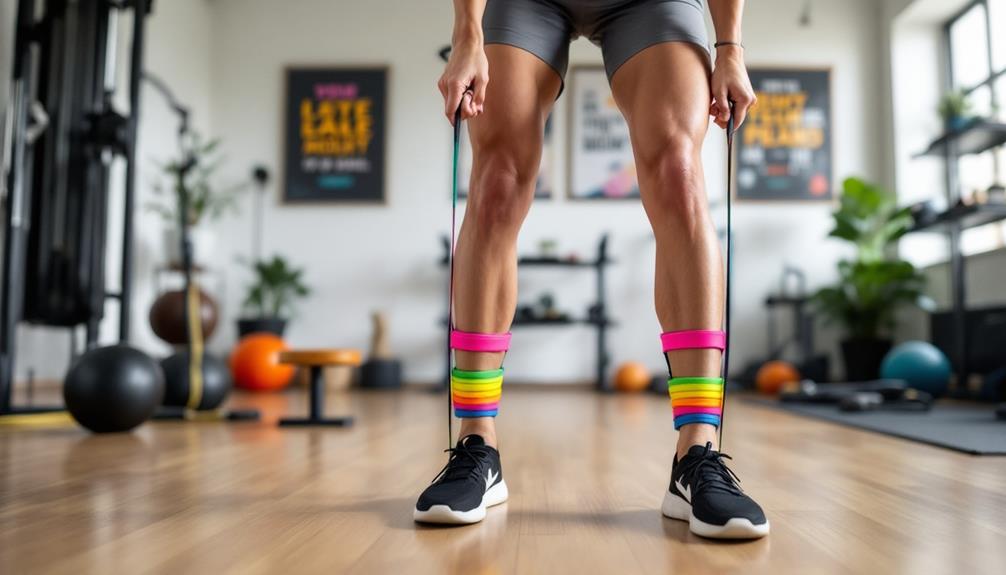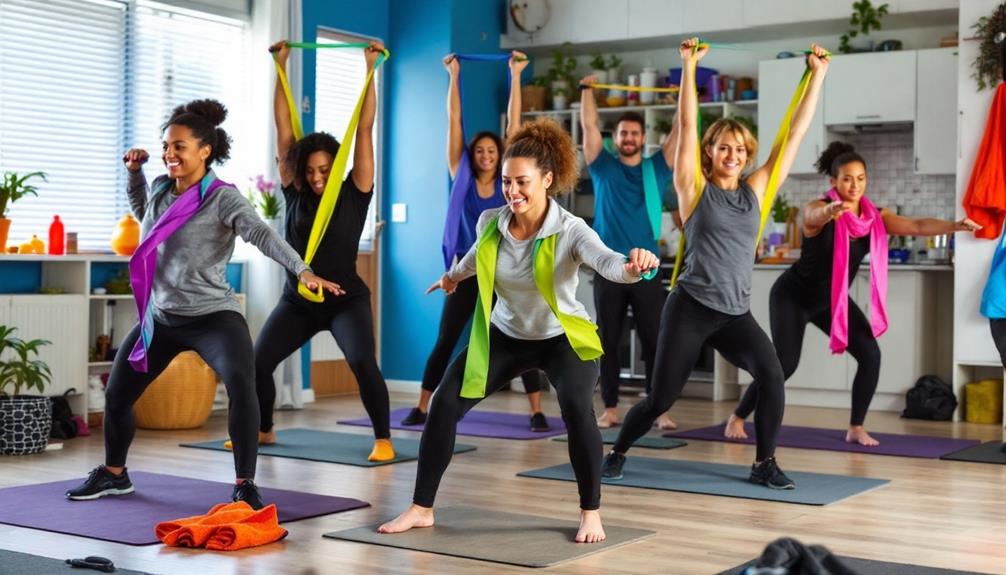Resistance band workouts are a great way to kickstart your fitness journey. They're versatile and effective for building strength and improving flexibility. Start with exercises like squats, resistance band rows, glute bridges, and lateral band walks. These moves engage multiple muscle groups, helping you achieve a full-body workout. Make sure you choose the right band resistance that matches your fitness level. Always maintain proper form to prevent injuries, and warm up beforehand. Incorporating techniques like overhead presses and cool-down stretches can enhance your routine. Stick around, and you'll uncover even more effective exercises and tips to elevate your workouts.
Core Insight
- Start with lighter resistance bands to ensure proper form and reduce injury risk as you learn essential exercises.
- Essential exercises include squats, resistance band rows, lunges, and glute bridges for full-body strength training.
- Engage multiple muscle groups by incorporating resistance bands into traditional exercises like bicep curls and shoulder presses.
- Maintain proper form and control during movements to prevent strain on muscles and joints, enhancing effectiveness.
- Always warm up before workouts and cool down afterward to promote flexibility and prevent injuries.
Understanding Resistance Bands

Resistance bands are often ignored, but they can really boost your workout routine. They are flexible, easy to carry, and work well for everyone, no matter your fitness level. To understand resistance bands, you first need to know the different types. There are loop bands, tube bands with handles, and figure-eight bands, each designed for specific exercises. When choosing resistance bands, think about factors like resistance levels, material quality, and the type of workout you plan to do.
Next, consider the resistance levels. Bands come in different thicknesses, which means they provide different levels of challenge for your muscles. It's a good idea to start with a lighter band to get your form right before moving on to heavier ones.
Also, learn the correct techniques. Make sure to anchor the band securely and keep tension during your exercises. This is crucial for both safety and getting the most out of your workout.
Benefits of Resistance Band Workouts

Resistance band workouts have many benefits for everyone, whether you're just starting out or have been exercising for a while. They come in different resistance levels, which means you can adjust them to fit your strength and fitness goals. These workouts also work multiple muscle groups at the same time, helping to build overall strength and stability.
Using resistance bands is safer for your joints than lifting traditional weights, which lowers the chance of getting injured. Bands also help improve your flexibility and mobility because they allow for a full range of motion during exercises. In short, resistance band workouts are a simple and effective way to reach your fitness goals.
Safety Tips for Beginners

Starting a resistance band workout can be fun, but safety is key, especially for beginners. Here are some simple tips to keep in mind.
Choose the Right Band
Pick a resistance band that fits your fitness level. Bands come in different strengths, so start with a lighter one. For beginners, look for bands with resistance levels around 8-15 lbs. You can increase the resistance as you get stronger.
Check for Damage
Before each use, check your band for any tears or damage. A worn-out band can break during exercise, which can lead to injury.
Maintain Proper Form
Pay attention to your form. Using the wrong technique can put stress on your muscles and joints. If you need help, watch some instructional videos.
Warm Up
Always do a warm-up before your workout. This gets your muscles ready and helps reduce the risk of injury.
Squats With Resistance Bands

- Position the Band: Place the resistance band just above your knees or under your feet, depending on what you prefer. Choose a band that has a resistance level suitable for you, typically between 8-35 lbs for beginners.
- Get into Position: Stand with your feet shoulder-width apart and engage your core muscles.
- Perform the Squat: Lower your body as if you are sitting back into a chair. Keep your chest up and make sure your knees stay aligned with your toes.
As you rise, push against the band to add more resistance. This exercise helps build strength and improves your squat form over time.
Resistance Band Rows

- Get Ready: Stand with your feet shoulder-width apart and keep your knees slightly bent. Choose a resistance band that matches your strength and fitness goals.
- Pull the Band: Keep your elbows close to your body and pull the bands toward you. Squeeze your shoulder blades together as you do this.
- Return: Slowly stretch your arms back to the starting position.
Aim for three sets of 10-15 repetitions. This exercise works your upper back and also engages your core, making it a valuable part of your workout routine.
Chest Press With Bands

The chest press with bands is a great way to work your chest muscles while also engaging your triceps and shoulders. This exercise is easy to do and helps build upper body strength. When choosing bands, look for resistance levels between 15-35 lbs for beginners and up to 125 lbs for more advanced users. Bands made from natural latex are best for good elasticity and durability. Here's how to do it:
- Anchor the Band: Secure the band behind your back or attach it to a sturdy object.
- Get in Position: Stand or sit with your feet shoulder-width apart, holding the band handles at your sides.
- Press Forward: Push the handles away from your chest, fully extending your arms, then return to the starting position.
Add the chest press to your workout routine for a well-rounded exercise plan. Remember to control your movements for the best results.
Glute Bridges Using Bands

Building strength in your lower body is just as important as working on your upper body. One effective exercise is the glute bridge using resistance bands. This move helps strengthen your glutes and improve stability. You can adjust the resistance level of the bands to match your fitness level, making it great for both beginners and advanced users. Here's how to do it:
Setup: Lie on your back with your knees bent and feet flat on the floor. Place a resistance band just above your knees.
Execution: Push your feet into the floor and lift your hips toward the ceiling, squeezing your glutes at the top. Hold for a moment, then lower back down.
Repetitions: Aim for 10-15 reps, and make sure your movements are controlled.
Using bands adds extra resistance to your workout, making it more challenging. This exercise not only works your glutes but also engages your core, helping you build overall strength.
Lateral Band Walks

- Setup: Put a resistance band just above your knees and stand with your feet shoulder-width apart. Pick a band that fits your fitness level, starting with a lighter band if you're a beginner.
- Movement: Slightly bend your knees and hips to keep a low position. Step side to side while keeping tension on the band.
- Repetitions: Try to take 10-15 steps in one direction, then return to where you started.
Add lateral band walks to your routine to help strengthen your lower body and improve your stability. You'll notice the benefits in your glutes and hips!
Overhead Press With Bands

Overhead Press With Bands
Using resistance bands can enhance your strength training, especially for the overhead press. This exercise works your shoulders, triceps, and upper chest, making it a great addition to your workout routine. Here's how to do it:
- Stand on the band with your feet shoulder-width apart.
- Hold the handles at shoulder height.
- Press upward until your arms are straight.
- Slowly lower back to the starting position.
To help you see the benefits, here's a quick comparison of the overhead press with bands versus traditional weights:
| Aspect | Resistance Bands |
|---|---|
| Portability | Highly portable |
| Joint Impact | Low impact |
| Resistance Variation | Adjustable tension |
| Setup Time | Quick and easy |
| Cost | Generally more affordable |
Add this exercise to your routine for better strength and stability!
Cool Down and Stretching Techniques

After a good workout, like doing the overhead press, it's important to cool down and stretch. This helps your body recover and prevents stiffness. Here are three easy techniques you can try:
- Static Stretching: Hold each stretch for 15 to 30 seconds. Focus on major muscle groups like your shoulders and legs. This helps improve flexibility and allows your body to relax. You can also use a foam roller to target specific muscles for better flexibility.
- Deep Breathing: Spend a few minutes taking deep breaths. Inhale through your nose and exhale through your mouth. This helps lower your heart rate and calms your mind.
- Foam Rolling: Use a foam roller on tight spots to relieve muscle tension. Slowly roll over each muscle group for about 30 seconds.
Frequently Asked Questions
How Do I Choose the Right Resistance Band Strength?
To choose the right resistance band strength, consider your fitness level and the exercises you'll perform. Start with a lighter band to master your form, then gradually increase resistance as you gain strength and confidence.
Can Resistance Bands Replace Free Weights Entirely?
Resistance bands can complement your workouts, but they can't fully replace free weights. Each tool has unique benefits. You'll find that combining both provides the best results for strength training and overall fitness development.
How Often Should I Do Resistance Band Workouts?
You should aim to do resistance band workouts at least two to three times a week. This frequency helps build strength and endurance while allowing your muscles enough time to recover and grow.
Are Resistance Bands Safe for Older Adults?
Yes, resistance bands are generally safe for older adults. They offer low-impact workouts, improve strength, and enhance flexibility. Just make sure you start slowly, use the right resistance, and consult a healthcare professional if needed.
Where Can I Buy High-Quality Resistance Bands?
You can buy high-quality resistance bands at sporting goods stores, online retailers like Amazon, or fitness specialty shops. Check reviews to guarantee durability and performance, and consider trying them out before making your purchase.

